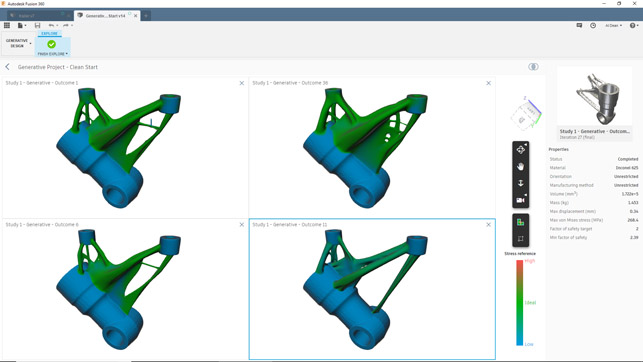Autodesk has announced that it’ll soon be introducing an all you can eat Fusion 360 Generative Design price plan.
Since Autodesk launched its generative design tool inside Fusion 360, we’ve seen all manner of folks trying it, experimenting with it and seeing what this potentially amazing design assistance system can do.
If you’re not familiar with Autodesk’s Fusion 360 Generative Design technology, think of it as topology optimisation, combined with some very smart design of experiments that allows you to not only investigate multiple load cases, but also include multiple materials and use a variety of manufacturing methods to help drive form creation, factor in cost and much more.
We’ve written about it a lot – an older feature is here.
It also does all of this on the cloud and using that cloud-based service can be costly, particularly for those looking to really push the limits.
Autodesk not only charge per computational solve (around the $25 mark) but also take a slice when it comes to taking the optima from your experimentation and pushing it into further validation and engineering work (generating am analytic solid/surface-based model of your results costs $100).
That changes with the new Generative Design Extension (details here) – essentially, this a Fusion 360 Generative Design price add-on for unlimited use of the service for that user, so there are no additional charges for compute or for download of results.
This is an ‘in application’ purchase, to use the modern parlance. You pay for it, you get it – per named user and no sharing of that infinite allowance.
The official Autodesk line is “These new subscription offerings are single user licensing, so they are intended for only one user to use. Generally, if a company would like to have several users, they may still find the flexible access model the best option as they can purchase a pack of Cloud Credits and share them between all participating users.” That said, I’m sure if you’ve got one person in your design team with the extension enabled, it’s not too much of a stretch to see a work around, right?
How much is it? Brace yourself, kids. The Generative Design Extension is either $1,000 per month (for monthly billing) or $666 per month (if you shell out your $8,000 annual fee upfront).
Yup. It’s an $1,000 add-on for a design system that costs $60 per month.
We’ve talked about this subject before, how engineering and design rely on experimentation and free thinking. We’ve also discussed how to make the most of simulation’s potential, it needs to be used heavily and iteratively, without worrying about how much you’re using it.
Personally, I love what Autodesk is doing with Fusion 360 (Have a look at this Roadmap – incredible work planned) and with generative design – what I can’t abide is the price per use model – that’s not how engineering and design works and it’s not how projects are funded/budgeted for.
This is an interesting announcement but it’s not without its challenges – dropping $1,000 a month on a service that provides results that you then need to validate further isn’t going to appeal to most.
Other vendors are also introducing new topology optimisation tools that run locally with the option to solve on the cloud either available now or in the near future (PTC Creo, Solid Edge, NX, Solidworks’ new tools and others).
Fusion 360 is priced very aggressively, and I understand that if you use a tool like this you could potentially be gaining huge benefit, but this just seems a little ridiculous, you know?
The decision to put this technology in the cloud is Autodesk’s alone. You could purchase some serious compute power (the GD tools, I believe, are predominately GPU-based) for that sort of money.
Fusion 360 has huge potential and is supposedly doing some very interesting numbers, but when its flagship differentiating technology is placed behind a pretty considerable paywall, you have to wonder what the future holds.






